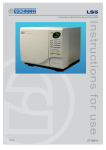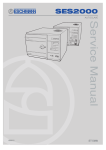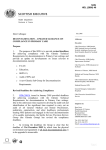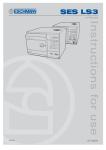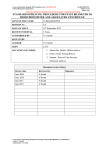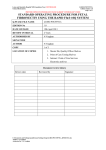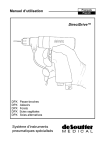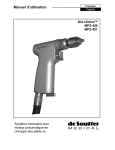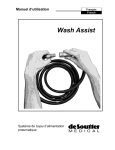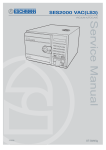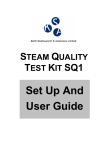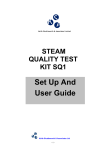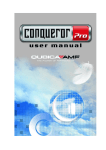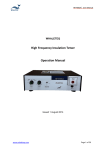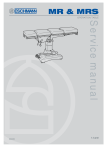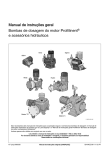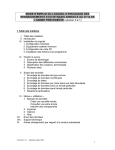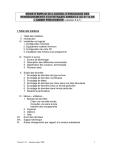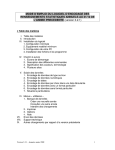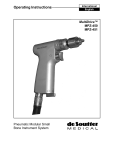Download Instructions for use - Frank`s Hospital Workshop
Transcript
Instructions for use SES 113 SES 113 B vacuum SES 225 B vacuum Contents Page Introduction . . . . . . . . . . . . . . . . . . . . . . . . . . . . . . . . . . . . . . . . . . . . 3 Suitable loads . . . . . . . . . . . . . . . . . . . . . . . . . . . . . . . . . . . . . . . . . . 3 EschmannCare . . . . . . . . . . . . . . . . . . . . . . . . . . . . . . . . . . . . . . . . . 3 1.0 Controls and displays . . . . . . . . . . . . . . . . . . . . . . . . . . . . . . . . 6 2.0 3.0 Getting started . . . . . . . . . . . . . . . . . . . . . . . . . . . . . . . . . . . . . 7 Running a cycle . . . . . . . . . . . . . . . . . . . . . . . . . . . . . . . . . . . . 8 4.0 5.0 Direct Data Download instructions . . . . . . . . . . . . . . . . . . . . . 10 Printer instructions . . . . . . . . . . . . . . . . . . . . . . . . . . . . . . . . . 13 6.0 Technical data . . . . . . . . . . . . . . . . . . . . . . . . . . . . . . . . . . . . 15 APPENDIX 1 - Installation . . . . . . . . . . . . . . . . . . . . . . . . . . . . . . . . 18 APPENDIX 2 - Warnings and cautions . . . . . . . . . . . . . . . . . . . . . . 19 APPENDIX 3 - Loading the autoclave . . . . . . . . . . . . . . . . . . . . . . . 21 APPENDIX 4 - Daily Testing, Vacuum ( B type) autoclaves . . . . . . 22 APPENDIX 5 - Maintenance . . . . . . . . . . . . . . . . . . . . . . . . . . . . . . 23 APPENDIX 6 - Cycle errors and faults and Display messages . . . . 24 APPENDIX 7 - Special Functions . . . . . . . . . . . . . . . . . . . . . . . . . . 26 APPENDIX 8 - Accessories and spares . . . . . . . . . . . . . . . . . . . . . 32 Figures P2/33 Fig. 1. Fig. 2. Identification of the main parts of the autoclave . . . . . . . . . 4 The main information display and control buttons . . . . . . . . 5 Fig. 3. Fig. 4. Filling and draining the reservoirs . . . . . . . . . . . . . . . . . . . . 5 DDD - Controls active, connected . . . . . . . . . . . . . . . . . . . 10 Fig. 5. Fig. 6. DDD - Download button symbols . . . . . . . . . . . . . . . . . . . 10 ‘Cycle Select’ and various display screens . . . . . . . . . . . . 11 Fig. 7. Fig. 8. Various display screens . . . . . . . . . . . . . . . . . . . . . . . . . . . 12 Printer control panel . . . . . . . . . . . . . . . . . . . . . . . . . . . . . 13 ST-IM84c SES 113 and 225 AUTOCLAVES Introduction The Eschmann Little Sister SES 113 and 225 autoclaves have been designed to meet the needs of the healthcare professional and have been designed in accordance with European Standards (e.g. BS EN 13060) and Department of Health guidelines. SES 113 Autoclave – The SES 113 is an ‘N’ type displacement autoclave with an 11 litre chamber. It is intended for the sterilization of solid instruments which have not been wrapped. SES 113 B Autoclave – The SES 113 B vacuum is a ‘B’ type vacuum autoclave with an 11 litre chamber. It is intended for the sterilization of solid and hollow instruments, pouched or wrapped instruments and porous loads. SES 225 B Autoclave – The SES 225 B vacuum is a ‘B’ type vacuum autoclave with an 22 litre chamber. It is intended for the sterilization of solid and hollow instruments, pouched or wrapped instruments and porous loads. Suitable loads The following table details the types of load that may be successfully processed in each model. Please refer to the table in the ‘Technical Data’ section for details of the cycles available on each model. Type of load and cycle type Solid instruments for immediate use (N) Solid instruments processed for aseptic storage (N) Hollow/cannula instruments (B) Single wrapped pouched instruments (B) Single wrapped cassettes (B) Single wrapped hollow instruments (B) Double wrapped instruments (B) Double wrapped hollow instruments (B) Porous loads (B) SES 113 SES 113 B Vacuum SES 225 B Vacuum 9 9 8 8 8 8 8 8 8 9 9 9 9 9 9 9 9 9 Warning markings The warning markings on this equipment have the following meanings: Caution; refer to accompanying documents (i.e. these Instructions for Use). Caution; hot surface. EschmannCare Eschmann recommends direct installation and commissioning in the UK for all its autoclaves by its own EschmannCare team of professional engineers. Eschmann also recommends a programme of after sales service and maintenance for all Eschmann autoclaves, using only the correct Eschmann spare parts. Service and maintenance programmes can include PSSR 2000 certification and testing to HTM 2010 (DB9804). The EschmannCare service department is staffed and equipped to provide advice and assistance during normal office hours. To avoid delays when making enquiries, please quote the Model and Serial Number of your Autoclave which is shown on the Serial Label, the location of which is shown in Fig. 1, item 20 please include all alpha and numeric digits. For further information visit www.eschmann.co.uk All correspondence relating to the after sales service of Eschmann Equipment to be addressed to : UK Customers EschmannCare, Peter Road, Lancing, West Sussex BN15 8TJ, England. Tel: +44 (0) 1903 765040. Fax: +44 (0) 1903 875711. Overseas Customers Contact your local distributor. In case of doubt contact Eschmann Equipment. ST-IM84c P3/33 1 3 2 4 24 5 18 6 7 17 8 9 16 15 14 20 13 12 11 10 21 18 23 22 19 1 2 3 4 5 6 7 8 9 10 11 12 Autoclave door Door handle Process display (Fig. 2) Start button (Fig. 2) Indicators (Fig. 2) Digital display (Fig. 2) Cycle select button (Fig. 2) Control buttons (Fig. 2) Printer Mains ‘on/off’ switch Adjustable foot USB port Part rear view 13 14 15 16 17 18 19 20 21 22 23 24 Part rear view Serial Label (front) Overheat indicator Waste water drain Waste water reservoir (Fixed) Fresh water drain Fresh water reservoir (Slides out to fill)) Drain release clip Serial label (back) Mains fuses IEC Mains connection Antibacterial air filter (B type units only) Basic instructions (UK models only) Fig. 1. Identification of the main parts of the autoclave P4/33 ST-IM84c SES 113 and 225 AUTOCLAVES Fig. 2. The main information display and control buttons (shown with all indicators illuminated and a typical ‘Cycle select’ display) Filling the fresh water reservoir (slide out) Draining the waste water reservoir (fixed) Each reservoir has a capacity of 3.36 litres. Fig. 3. Filling and draining the reservoirs ST-IM84c Drain tube (before connection, direct end into a suitable container of at least 4 litres capacity ) P5/33 1.0 Controls and displays Mains switch (Fig. 1, item 10) The mains switch is positioned on the front of the autoclave. The symbol ‘I‘ indicates ‘on’ and the symbol ‘0’ indicates ‘off’. The switch illuminates green when ‘on’. Push buttons Cycle select button (Fig. 1, item 7). Press to select a sterilization cycle. The Autoclave Manager may have enabled more than one cycle. Cycle details will be shown in the main display. After scrolling the available cycles which may include the test cycles (T1 and T3), the ‘Cycle Count’ (the number of cycles started) will be displayed. Start (cycle) button (Fig. 1, item 4). Press to start the selected cycle. Control Buttons. The control buttons shown in Fig. 2 are behind the hinged panel (below the main display). Their use is explained in Appendix 7, ‘Special functions’. They are not required during ‘normal’ use of the autoclave. Note: When a button is pressed a ‘beep’ will sound (unless disabled, refer to Appendix 7 - ‘Audio’). Digital display (Fig. 2) The digital display provides the information required during ‘normal’ use of the autoclave (e.g. to select the required cycle) and to provide information on the cycle status. It may display other details, instructions and warnings as detailed in this manual and configuration information when using the ‘Special Functions’. Indicators (Fig. 2) ‘Low water’ indicator. When illuminated the fresh water reservoir (top one) should be refilled before a new cycle is started (section 2). It will flash if the reservoir is low and an attempt to start a cycle is made. ‘Drain reservoir’ indicator. When illuminated the waste water reservoir (bottom one) is full and should be emptied before a new cycle is started (section 2). It will flash if the reservoir is full and an attempt to start a cycle is made. Door indicator. This is illuminated to indicate the door is locked, or flashing to indicate the door should be opened or closed (the digital display provides a related message). It will be off after you close the door prior to starting a cycle. Cycle complete indicator. This is illuminated at the end of a successful completed cycle. Progress indicators. The display has indicators that illuminate in turn as the cycle progresses. The main stages are identified by three symbols. The symbols and stages are detailed below: 1 2 3 4 5 6 7 8 9 Pre conditioning. P6/33 – – – – – – – – – Cycle started Water fill completed Heating to sterilization temperature Sterilization started Sterilization stage passed halfway Condensing Drying started (vacuum only) Less than 1 minute remaining to cycle completion Cycle completed successfully Sterilizing. Post sterilization cooling/drying. ST-IM84c SES 113 and 225 AUTOCLAVES 2.0 Getting started WARNING Read these instructions before use and keep them in a safe convenient place for future reference. The use of this autoclave should be under the control of a person with adequate training (the Autoclave Manager*). The Autoclave Manager* is responsible for ensuring that the correct sterilization cycle is used for the items being sterilized, ensuring that records are kept correctly and keeping the amended PIN code confidential (refer to Appendix 7 Special functions). The autoclave should only be used as specified by Eschmann as detailed within these instructions. Never tamper with, bypass or interfere with any of the safety features. There are no ‘user’ serviceable parts inside the autoclave. Eschmann Equipment is not responsible for malfunction, or a reduced level of protection provided by the equipment, if it is used in a manner not specified in these instructions. Only use Eschmann accessories and mains leads. Any spare parts required must be supplied by Eschmann. They must be fitted in accordance with the Service Manual or the instructions supplied with them by EschmannCare engineers or engineers who have been trained by Eschmann. * Autoclave Manager - The person who is ultimately accountable for the operation of the premises. Depending on the nature of the organisation, this may be the owner, or other person of similar authority. In small, autonomous installations the manager might also be the user. Autoclave Installation Full installation details are provided in APPENDIX 1, this includes a list of items supplied with the autoclave and a note to observe if the autoclave is relocated. Ensure the autoclave has been correctly installed before use, by an EschmannCare trained engineer (contact the EschmannCare team on 01903 765040). Installation will also include initial training covering the use of these autoclaves. It is essential that the autoclave is levelled and connected to the electrical mains supply correctly. On request and during installation, programmes and autoclave configuration can be adjusted by the EschmannCare engineer. (To protect against tampering, access for such adjustment can only be gained by use of a PIN code). Direct Data Download (DDD) Software Installation Refer to the instructions provided with the Direct Data Download Software and install the DDD application. Warnings and Cautions Before using the autoclave ensure you understand the ‘Warnings and Cautions’ which are set out and summarised in APPENDIX 2 . RESERVOIR CARE AND WATER QUALITY CAUTION a. Eschmann recommends filling the water reservoir with ‘Sterile Water for Irrigation’. This is low in dissolved solids and has a low microbial count. In the U.K. the Department of Health recommends that ‘Sterile Water for Irrigation’ is used in bench-top Autoclaves (NHS Estates document HTM2031). b. If ‘Sterile Water for Irrigation’ is not being used then Eschmann strongly recommends the use of either distilled water, deionized water, purified water or water treated by the reverse osmosis process. These types of water are low in dissolved solids and can help reduce the effects of tap water detailed below. c. DO NOT USE TAP WATER, this is high in dissolved solids and can deposit lime scale, block filters and cause damage to the pressure vessel. d Don’t leave water standing in the reservoir for more than a few hours. If you are not sure how long the water has been there, change it. Also contents of part used containers of sterile water for irrigation should be discarded (microbiological purity will be compromised once opened). e At the end of the working day, or whenever the sterilizer is to be left unused for several hours, drain both the water reservoirs and leave them to dry. Fill the reservoir Open the left hand access door (Fig. 3) and slide the (top) fresh water reservoir out about 100 mm. Press down gently the back of the reservoir cover, slide it forward and remove it (Fig. 3). DO NOT USE TAP WATER. Fill the reservoir up to the ‘MAX’ mark engraved on the internal mesh cover (3.36 litres maximum). When the reservoir is filled to the ‘MAX’ mark the autoclave will run 8 cycles before it needs to be filled again Replace and slide the reservoir cover back until it clicks into position and return the reservoir to its normal (rear) position before using the autoclave. Close the left hand access door. ST-IM84c P7/33 3.0 Running a cycle Switching ‘on’ and ‘off’. Switch the autoclave ‘on’ using the mains switch (Fig. 1, item 10). The digital display and applicable indicators will illuminate to show the autoclave has been switched ‘on’. After normal checks and a ‘Welcome’ message (shown for 30 seconds, for the first few cycles) the ‘Cycle select’ screen will be displayed (Fig. 6). If the door is closed the green door indicator will flash to indicate the door should be opened, together with a display message ‘Open Door’. To switch the autoclave ‘off’ press ‘0’ on the mains switch. Notes: 1 2 At times, the message ‘PLEASE WAIT’ may be displayed for a few seconds. ‘B’ type autoclave - If running test T1, run it directly after switching ‘on’ (a cold and dry chamber). For notes on T1, refer to Appendix 7 - Special Functions. To open the door. The autoclave must be switched ‘on’. Once the normal ‘Cycle select ‘ display is shown (Fig. 6) turn the door handle anticlockwise until vertical (12 o’clock position). The green door indicator light will flash. To close the door onto the secondary catch. With the handle vertical push the door closed gently and turn the door handle 45° clockwise (2 o’clock position). It will meet a stop at this position and the door will only be partially closed. The door should be shut onto the secondary catch at all times when the autoclave is not in use. To close the door fully. With the handle vertical push the door shut firmly and turn the door handle clockwise until horizontal (3 o’clock position). The door indicator light will stop flashing and will not be illuminated. Loading Note: Prior to sterilization, instruments should be thoroughly cleaned, ideally in an Eschmann Instrument Washer Disinfector. Open the door fully. The door indicator light will flash, indicating the door should be closed (after loading) together with a display message ‘Close Door’. Following the guidance provided in APPENDIX 3 and local procedures, load the autoclave with the items to be sterilized. Reservoir warning If a Reservoir Warning Indicator (detailed on page 6) is illuminated ( to page 7 (Fill the reservoir) or page 9 (Draining a reservoir) as required. ), fill or drain reservoir as indicated referring Closing door Close the door fully. The green door indicator light will stop flashing and will not be illuminated. Cycle selection The digital display indicates the default cycle. If another cycle is required press the ‘Cycle select’ button ( required cycle is displayed. Ensure the cycle is appropriate for the load (refer to section 6). ) until the Starting cycle Press the ‘Start (cycle)’ button . The green door indicator light will illuminate indicating the door is locked and cannot be opened until cycle completion. The printer (if fitted) will start printing a cycle record (refer to section 5). Indicators will show the status of the cycle. The digital display will indicate the chamber temperature, pressure and an animated progress bar. The ‘Cycle Count’ can be displayed if the ‘Cycle select’ button is pressed during a cycle (Fig. 6 and 7). Note: Cycles cannot be started when the green door indicator is flashing and the ‘Open Door’ message is displayed. Open and then close the door to correct this situation should it occur. Cycle errors WARNING When a cycle is aborted and/or an error display is indicated, the load must be treated as non-sterile. The load must be sterilized by running the cycle again. If wrapped or pouched, new packaging must be used. If the autoclave detects a fault it will display a message (e.g. ‘Door not closed’, Fig. 6) or if it detects an error it will display ‘CYCLE FAILED’ or ‘SYSTEM ERROR’, there will be five rapid ‘beeps’ and illuminated progress indicators will flash. Refer to ‘Errors and Faults’ Appendix 6. Anyone who becomes aware of a fault when using the autoclave should report it immediately to the Autoclave Manager and all necessary remedial action should be taken before the autoclave is used again. Should the overheat cutout trip, its indicator light (Fig. 1, item 14) will illuminate, refer to Appendix 6. Completed cycles Completion of a successful cycle will be indicated by illuminating and the display showing ‘Cycle Complete’ and ‘Ready to Open’, the normal end of cycle display (refer to Fig. 6). There will be three audible ‘beeps’ (unless disabled). Open the door fully (take care - the load will be hot) and remove the load using the tray lifter. Note: On ‘N’ type autoclaves ONLY, at the end of cycles with drying, the beep (if enabled) will continue intermittently. During these ‘beeps’ open the door and remove the load. It should still be hot enough to self-dry. If the door is not opened during the intermittent ‘beeps’ the load may not dry when removed. Items sterilized using an ‘N’ type cycle are for immediate use only. P8/33 ST-IM84c SES 113 and 225 AUTOCLAVES Unloading the chamber WARNING: TAKE CARE WHEN UNLOADING, THE LOAD AND CHAMBER MAY BE VERY HOT. Use the tray lifter as detailed in the following section. If running consecutive cycles, Eschmann recommends waiting for five minutes between cycles with the door open to allow the chamber conditions to stabilise. If the autoclave is not to be used for several minutes close the door onto the secondary catch (as detailed opposite). Using the tray lifter. The tray lifter has one bottom support and two pairs of top clips. The top pair is for Hand Free instrument Transfer (HFiT) cassettes and the bottom pair is for trays. Do not use the top clips when lifting trays. The spacing of the top clips enables HFiT cassettes to be held at the side or end. Refer to illustrations below: Tray in bottom clips CORRECT Tray in top clips INCORRECT HFiT cassette gripped at the side. HFiT cassette gripped at the end. When using a tray lifter to hold pouch racks or the porous load basket, ensure the rack or basket is correctly located as illustrated below: End bar of pouch rack or basket located in tray lifter’s top centre clip. Second bar of pouch rack or basket located in the tray lifter’s top channel. Stopping a cycle In the unlikely event of needing to stop a cycle (e.g. wrong cycle selected) press the ‘Cancel (Exit)’ button (Fig. 2). This will induce ‘Cycle Error No. 02’. Refer to ‘Errors and Faults’ Appendix 6 to clear this error and start the cycle again. Draining a reservoir The ‘waste water’ reservoir will need emptying when illuminates. WARNING: TAKE CARE THE WASTE WATER MAY BE VERY HOT. Using the drain tube supplied (if lost a replacement can be ordered, Part No. 115036) drain the water into a container of at least 4 litres capacity, or a sink. Plug the drain tube’s connector into the drain socket (Fig. 1, item 15) this automatically opens the socket’s drain valve, if the plug cannot be pushed into the drain, push the drain release clip (Fig. 1, item 19) until it clicks and then insert the plug. Release the red clip on the end of the drain tube with the drain tube pointing into the container or sink. Note that a direct drain kit (REF 87-271-55) can be fitted, please contact EschmannCare for details. Also note that the waste water reservoir is fixed. To release the drain tube from the autoclave push the drain release clip (Fig. 1, item 19). Don’t forget to close the red clip. To drain the fresh water reservoir pull it forward about 100mm (as for filling, Fig. 2) and drain the water into a 4 litre container as detailed above, but plug the drain tube’s connector into the fresh water reservoir’s drain socket (Fig. 1, item 17). After use (end of day) When the autoclave is not in use switch it ‘off’ at the mains switch (Fig. 1, item 10). Also leave the door open on the secondary catch with the chamber empty. Note: Whenever a B type autoclave is switched ‘on’ the chamber is heated. At the end of the day and/or week ensure the instructions for care of the autoclave are followed as detailed in Appendix 5. It is recommended that the ‘waste water’ and the ‘fresh water’ reservoirs should be drained and allowed to dry, at the end of each day. Display ‘beep’ and Special function’ notes At programmed intervals the autoclave will display special messages (e.g. ‘Service required’), refer to Appendix 6. The autoclave will sound 5 rapid ‘beeps’ if there is a fault, 3 slower ‘beeps’ on cycle complete and one ‘beep’ per key press. The ‘beep’ can be disabled using the ‘Special Functions’, refer to Appendix 7. ‘Special functions’ should only be used by the Autoclave Manager or an EschmannCare engineer, refer to Appendix 7. ST-IM84c P9/33 4.0 Direct Data Download instructions Introduction The Eschmann Little Sister SES 113 and 225 autoclaves include Direct Data Download (DDD) application software as standard. All cycle records are stored on the unit. IMPORTANT After 20,000 cycles the autoclave’s memory may be getting full and data storage could stop, please contact Eschmann for details of how the autoclave’s memory can be replaced. DDD allows cycle records to be downloaded via a USB cable direct to a PC or Laptop. Cycle records can then be stored directly on the PC, printed out using a conventional printer, several records to a page or, ‘pasted’ directly into the computerised patient record. DDD enables the implementation of instrument/patient management and traceability. DDD application removes the need for an integral printer and the issues relating to accurately managing this type of paper based data. Using the DDD application If in doubt refer to the instructions supplied within the Application CD or contact Eschmann. The DDD application software should be installed on a PC, refer to the instructions provided with the DDD Software. To open the DDD application click on the DDD icon on the Desktop of your PC or Laptop. Using the cable provided connect the PC to the autoclave’s USB port (Fig. 1, item 12). Switch on the autoclave. The application will access the autoclave, refer to Fig. 4. Start Disk button Stop Progress bar Fig. 4 Controls active, Connected Click the ‘disk button’ (Fig. 4) to select the type of download required. The image shown next to the ‘disk button’ indicates which files you are about to download, refer to Fig. 5. For single files enter the cycle number in the box provided. Single file Files not downloaded All files Fig. 5 Type of download, symbols After selection, click the green button to start the download. If required click the red button to stop. The ‘Progress bar’ (Fig. 4) shows the download progress and the following: Off = Green = Red = Yellow = Normal File retrieval is complete, all files retrieved OK. An error occurred that prevented the retrieval. Retrieved all files but at least one was corrupt. To view files, browse to the user allocated folder storing these files. If the letter ‘E’ appears by the cycle number, this file is corrupt. You may try to retrieve this again as a single file. If in doubt refer to the instructions within the DDD Application CD. P10/33 ST-IM84c SES 113 and 225 AUTOCLAVES Fig. 6 ‘Cycle Select’ and various display screens ST-IM84c P11/33 Fig. 7 Various display screens P12/33 ST-IM84c SES 113 and 225 AUTOCLAVES 5.0 Printer instructions All Eschmann Little Sister SES 113 and 225 autoclaves incorporate direct data download via a USB port. They may also be bought with a built-in printer. Installation of a printer can also be arranged at a later date through the EschmannCare service team (contact 01903 765040) and order REF 87-270-23 a printer for these autoclaves, fitted with 1 roll of paper and 4 spare rolls. (Note: This must be fitted by an EschmannCare Engineer) 5.2 Interpretation of printer output The most important part of the printout that should be checked is the final line coded [STS], this should be followed by Cycle Complete indicating a successful cycle. Should any aspect of the cycle not match the correct parameters the indication following [STS] is ***FAIL***. This will be accompanied by an error number, refer to ‘Appendix 6 - Errors and Faults’. The following instructions only apply to autoclaves fitted with a Other aspects of the printout that can be checked if required are printer. as follows, but note that any deviation will result in the ***FAIL*** message above:IMPORTANT OPERATOR NOTES Follow the notes and cautions below when changing the 121°C Cycles: paper roll. Do not pull on the paper whilst the printer is in [TSS], [TSE], [TMX], [TMN] operation, since it may damage the printer. Temperature - >121°C <124°C Time [TSS] - Time [TSE] not less than 15 minutes 5.1 Printer Output The printer output (refer to example below) gives the following information: 134°C Cycles: [TSS], [TSE], [TMX], [TMN] Temperature - >134°C <137°C Time [TSS] - Time [TSE] not less than 3 min. 20sec. Autoclave type - Eschmann Little Sister SES 113B Autoclave Serial number [SRN] - A unique code 5.3 Printer operation Cycle type [CYC] (e.g. B134) followed by, Cycle count (e.g. 00345) Time and Date started [STD] - hh:mm:ss dd\mm\yy Cycle information - Cycle stage codes (key to codes is below) with time, pressure and temperature. Sterilization information - Time, pressure and temperature every 20 seconds during sterilization. Maximum sterilization temperature [TMX] Minimum sterilization temperature [TMN] Time and Date finished [ETD] - hh:mm:ss dd\mm\yy Fig. 8 Printer control panel Status [STS] followed by Cycle Complete or ***FAIL*** Error number [ERR] - If applicable If an error occurs during a cycle, it is recorded with time and 5.3.1 Status LED date on the printout and the message ***FAIL***, errors are The printer incorporates a Status LED (Fig. 8) to report its designated by error codes, refer to Appendix 6. condition. If there is a fault, the LED will flash in sequence. The Key to codes on printout (if not detailed above) are: fault can be identified by observing the flash sequence detailed TPV Time of vacuum pulse below. TPP Time of pressure pulse LED On continually Printer On TSS Start of sterilization LED Off Printer Off TSE End of sterilization LED flashing * * * Paper out, fit new roll TDS Start of drying phase LED flashing ** ** ** Thermal head too hot, TDE End of drying phase allow head to cool. ETD End time and date STS ST-IM84c - Status at cycle end P13/33 5.3.2 Loading paper Do not close the lid with one finger as shown below. CAUTION DO NOT USE ALTERNATIVE PAPER ROLLS The quality and size of paper rolls used in the printer, should only be supplied by Eschmann. The printer will automatically detect when the printer’s paper has run out and report this using the Status LED (section 5.3.1). Use the Paper feed button to feed through the last few centimetres of paper and fit a new roll as follows: i Pull the top of the opaque centre window (at the finger hold) forward until the lid is released from its locked position. To v avoid damage do not use excessive force. Now tear the spare paper away by pulling the printout down towards the tear bar and tear from one side to the other across the serrated edge. ii Remove any paper remaining in the paper recess. 5.3.3 Removing a printout iii Reel off a few centimetres from a new roll of paper. Hold approximately 50 mm of paper outside the printer as you place the new roll into the paper’s recess with the roll unwinding from the back and bottom of the roll when placed in the recess (left picture below). Note the paper can only be printed on one side (the outside of the roll), do not place the roll in back to front. Push the paper feed button to advance the paper about 5 mm if required. To remove a printout from the printer, pull the printout down towards the tear bar and tear from one side to the other across the serrated edge as ‘5.3.2 - v’. 5.3.4 Printer door During use the printer door can be closed, the printout will feed through the recess in the bottom of the door. When closing the door hold the printout down and take care not to trap any paper in the door. 5.4 Printer maintenance Power On Self Test The self test procedure is initiated by supplying power to the printer (i.e. switch the autoclave on) whilst depressing the paper feed button (Fig. 8) until the printer starts printing the test print. iv Head Thermal Limit Close the lid by applying equal amounts of pressure on After extensive printing the print head temperature may rise to each side, ensure the lid is in the locked position. an unacceptable level. The Status LED will report when this occurs (section 5.3.1). Printing will be suspended until the head temperature returns to normal levels, once cooled the printout will continue and no information will be lost. Spares Pack A spare printer roll will be provided with the autoclave, when you require more please contact the EschmannCare team on 01903 765040 and order the following: REF 87-270-45 a set of 4 thermal paper rolls for the Eschmann Little Sister SES 113/113 B vacuum autoclaves. P14/33 ST-IM84c SES 113 and 225 AUTOCLAVES 6.0 6.1 Technical data Electrical 6.5.2 Dimensions and Weight (approx.) 225 autoclave Supply 230 V (±10%) or 220 V (-6%, +15%), see rating plate. 50/60 Hz a.c. For use with alternating current Loading at 220 V 1.85 kW 10 A (max.) Loading at 230 V 2.0 kW 10 A (max.) Fuses: 2 - T12.5A 440 V (Part No. 112474) Protection Class I 6.2 Dimensions: 582 mm wide, 435 mm high*, 580 mm deep *435±5 mm depending on adjustment of feet. Weight: SES 225 B vacuum - 48 kg Shipping (includes unit, accessories and packing): Dimensions (WxDxH): 720 x 720 x 640 mm Weight: SES 225 B vac. - 60 kg Sterilizing and test data Sterilizing time (refer to Note below): 3 minutes 20 seconds at 134/137 °C, or 15 minutes at 121/124 °C The useable space is defined as: Trays carrier 370 mm length by cross section shown. 197 mm ‘B’ type cycle drying time (if selected) is 15 minutes. Maximum time for T1 - less than 20 minutes Maximum time for T3 - less than 25 minutes Operating pressure: 1.03 bar at 121 °C, 1.23 bar at 124 °C 2.03 bar at 134 °C, 2.32 bar at 137 °C For basic cycle details refer to section 6.12 and for more detailed cycle information sections 6.13 to 6.14. Note. An Eschmann trained engineer can increase the sterilization times (up to a max. of 30 minutes) on request, contact the EschmannCare team on 01903 765040. Chamfers 20 x 20 mm 197 mm 6.6 Standards compliance These autoclaves have been designed in accordance with the following standards: BS EN 13060: 2004 BS EN 980: 2003 PD 5500: 2006 BS EN 61010-1: 1993 BS EN 61326: 1998 Class A BS EN 1041:1998 EN 61010-2-041: 1997 BS EN ISO 14971: 2007 6.3 Maximum Loads 6.4 113 autoclave Maximum load per tray, pouch rack or cassette is 1.5 kg. Maximum load for the porous load basket is 0.87 kg. 6.7 Applicability Maximum weight per item is 1.5 kg. Maximum total load is 3 kg. This manual applies to the following autoclave models:225 autoclave SES 113 Autoclave (N type) (from Serial Number Maximum load per tray, pouch rack or cassette is 1.5 kg. L1NA.... or S1NA.... or S1XA....) REF 87-11*-** Maximum load for the porous load basket is 1.0 kg. SES 113 B Vacuum Autoclave (B type) (from Serial Maximum weight per item is 1.5 kg. Number L1BA.... or S1BA....) REF 87-12*-** Maximum total load is 6 kg. SES 225 B Vacuum Autoclave (B type) (from Serial Water and reservoir Number L2BA.... or S2BA....) REF 87-13*-** Reservoir capacity - 3360 ml (maximum) Minimum fill - 750 ml (approx.) Volume used for 1 cycle - 350 ml (approx.) 6.5.1 Dimensions and Weight (approx.) 113 autoclave Dimensions: 582 mm wide, 435 mm high*, 530 mm deep *435±5 mm depending on adjustment of feet. Weight: SES 113 - 35.0 kg, SES 113 B vacuum - 39.5 kg *-** indicate model variant numbers 6.8 Environmental considerations During cleaning and disinfection procedures any potentially contaminated waste materials produced during these actions, should be handled in accordance with local procedures and National legislation for the disposal of potentially contaminated waste. At the end of the working life of the autoclave it should be dismantled and recycled as much as possible in line with the recommended procedure available from Eschmann Equipment and in accordance with local procedures and National legislation. Shipping (includes unit, accessories and packing): Dimensions (WxDxH): 720 x 720 x 640 mm Weight: SES 113 - 46.5 kg, SES 113 B vac. - 51.5 kg 6.9 Technical Lifetime The Eschmann Little Sister SES 113 and 225 autoclaves are The useable space is defined as: designed to have a technical lifetime of 36,000 operating cycles Porous load basket: 280 x 147 x 87 mm (external) (10 years normal use) subject to their being used in accordance Trays cassettes etc.: 290 mm by cross section with these instructions, and subject to proper maintenance and shown (dimensions in mm) repair. 6.10 International Symbols This symbol indicates that the equipment is for use on alternating current. This symbol indicates that fuses adjacent to the symbol have a rating and type as detailed. ST-IM84c P15/33 This symbol warns the user to read the accompanying documents, these ‘Instructions for use’. SN This symbol indicates the unit serial number is as indicated adjacent to the symbol. REF This symbol indicates the catalogue number is as indicated adjacent to the symbol. This symbol indicates that the date of manufacture is as indicated adjacent to the symbol. This symbol indicates the manufacturer is as indicated adjacent to the symbol. This symbol warns the user of potentially hot surfaces. This symbol indicates that this product was placed on the market after 13th August 2005. At the end of its working life it should be deposited at an appropriate facility to enable recycling. For information on how to recycle this product responsibly contact Eschmann. 6.11 Miscellaneous For ‘Conditions for safe use’ refer to Appendix 2. The autoclave will be ready for use (after initial installation and setup) in less than 1.0 minute. The pressure relief valve is nonadjustable and set to 2.85 bar*. * Catalogue numbers ending ‘...4-80’ or ‘...3-80’ have an adjustable pressure relief valve set during manufacture to 2.85 bar. P16/33 ST-IM84c SES 113 and 225 AUTOCLAVES 6.12 Basic cycle information CYCLE DETAILS Cycle No. Cycle Type Load Type, Cycle Information 1 N134 °C Solid instruments (unwrapped), non vacuum and no drying. 2** N121 °C Solid instruments (unwrapped), non vacuum and no drying. 3 N134 °C Dry Solid instruments (unwrapped), non vacuum with drying. 4** N121 °C Dry Solid instruments (unwrapped), non vacuum with drying. 5 B134 °C Solid or Hollow instruments, vacuum cycle without drying. 6** B121 °C Solid or Hollow instruments, vacuum cycle without drying. 7 B134 °C Dry Solid or Hollow instruments and porous loads, vacuum cycle with drying (items can be pouched, single or double wrapped). 8* B121 °C Dry Solid or Hollow instruments and porous loads, vacuum cycle with drying (items can be pouched, single or double wrapped). T1 Test 1 Chamber integrity test. MUST NOT be used to process loads. T3 Test 3 Steam penetration test. MUST NOT be used to process loads. * ** This cycle is not normally installed on any autoclave. Not installed on SES 225 B vacuum autoclave Note: On ‘N’ type autoclaves ONLY, at the end of cycles with drying, a beep will continue intermittently. Refer to section 3 ‘Completed cycles’. 6.13 Detailed cycle information The operating cycles are detailed in the diagrams and explanation text provided in 6.13 and 6.14. These sections detail the maximum temperature for each sterilization cycle (within the useable space). The autoclave can be fitted with a printer producing cycle records, interpretation of the printout is detailed in section 5. Note: The configuration of the load support system is detailed in Appendix 3. In accordance with BS EN 13060 the relevant type tests for the cycles listed, are as below: Sterilization cycle type and cycle number Type tests B type cycle Dynamic sterilizer chamber pressure Air Leakage Empty chamber Solid load Small porous loads Full porous load Hollow load A Dryness, solid load Dryness, porous load Residual air X X X X X X X X X N type cycle X X X: in compliance with all applicable clauses of BS EN 13060 ST-IM84c P17/33 6.14 Detailed ‘N’ type cycle (N type autoclave) information Stage on diagram 1 Stage detail Water enters chamber (i.e. the boiler is filled with the correct volume of water) 2 Pressure rises during initial heating to 90 °C 3 Air removal stage, temperature held at 90 °C 4 Pressure rises (i.e. heating to sterilization temperature) N134 - 134 °C to 137 °C (approx. 318 kPa) N121 - 121 °C to 124 °C (approx. 215 kPa) 5 Sterilization, temperature and pressure held (i.e. at temperature and pressure as above) 6 Chamber pressure reduced to atmospheric (i.e. condensing and draining chamber) 6.15 Detailed ‘B’ type cycle information Stage on diagram Stage detail 1 Pressure drops to below 15 kPa (Initial vacuum) 2 Pressure increase as chamber (i.e. boiler) fills with the required volume of water 3 Initial pressure rise during initial heating (temperature is pressure related) B134 pressure is - 175 to 185 kPa B121 pressure is - 125 to 135 kPa 4 Pressure maintained as above, the precondition hold 5 Pressure drops to below 30 kPa, the steam penetration pulse 6 Pressure rises (i.e. heating to sterilization temperature) B134 - 134 °C to 137 °C (approx. 318 kPa) B121 - 121 °C to 124 °C (approx. 215 kPa) 7 Sterilization, temperature and pressure held (i.e. at temperature and pressure as above) 8a,b,c Cycle without drying - pressure returned to atmospheric pressure Cycle with drying - drying pulses of varying pressure Note: For cycles with drying there are several drying pulses, the chamber is then returned to atmospheric pressure. P18/33 ST-IM84c SES 113 and 225 AUTOCLAVES APPENDIX 1 - Installation These Autoclaves should be installed by an EschmannCare or Eschmann Trained Engineer. For Warranty Registration, Free Installation and Free User Training contact EschmannCare on 01903 765040. Programmes and autoclave configuration can be adjusted by an EschmannCare or Eschmann Trained Engineer, on request. To protect against tampering, access for such adjustment can only be gained by use of a PIN code, refer to ‘User PIN number’ below. The Autoclave should be lifted or moved by at least two people. Observe good manual handling techniques at all times, with hands placed under the base each side of the autoclave. Unpacking Remove the outer packaging and all packaging pieces carefully and place the autoclave on a flat, water and heat resistant surface. Ensure there is a working clearance of 50mm around the unit. Do not cover the ventilation ports at the rear or side of the autoclave. The following items should be checked and placed to one side (some will be packed within the chamber). All packaging should be recycled in accordance with local recycling practices. DO NOT connect to the mains until setup has been completed. Items included with the autoclave: Instructions for Use Levelling bull’s-eye Drain tube Furniture (model specific) Misc. Documentation Mains power cable Spare printer roll (if printer fitted) Tray carrier and tray lifter DDD Software (CD, Manual and USB cable) Setup Adjustable feet enable the autoclave to be levelled correctly. To adjust the feet slacken the locking nut, adjust the height as required and tighten the locking nut. The autoclave should be adjusted (when the chamber is cold) until level in all directions using the bull’s-eye levelling device supplied. Note that on ‘B’ type units the band heater will warm the chamber when switched on, once the door has been opened switch the autoclave off until levelled. The levelling device should be positioned directly on top of the flat heater plate inside and at the back of the chamber. IMPORTANT Remove levelling device before use and if moved to a new location after installation, check the autoclave is levelled again, adjusting if required. Mains connection WARNING This equipment must be earthed. Ensure that the mains plug is easily accessible during use as this is the means of disconnection. The autoclave is supplied with an IEC mains input socket at the rear and a mains power cable. If the cable has a fused plug the correct fuse will be installed. Connect the mains power cable (as supplied) to the mains supply and to the rear IEC mains socket (Fig. 1, item 22). DO NOT use equivalent mains leads. Switch the mains supply ‘on’ if controlled by a switch. If changing the plug, ensure that the plug is earthed. Check the fuse (if a fused plug) is appropriate for the equipment. The connections to observe when connecting a mains plug are: Yellow/Green - Earth Brown- Live Blue - Neutral Switch the autoclave ‘on’ using the mains switch (Fig. 1, item 10). The switch is marked ‘0’ for ‘off’ and ‘I’ for ‘on’ it illuminates green when ‘on’. The digital display and applicable indicators will illuminate to show the autoclave has been switched ‘on’. After normal checks and a ‘Welcome, Please contact Eschmann’ message (shown for 30 seconds, for the first few cycles) the ‘Cycle select’ screen will be displayed. To switch the autoclave ‘off’ press ‘0’ on the mains switch. Opening/Closing the door To open the door. The autoclave must be switched ‘on’. Once the normal ‘Cycle select ‘ display is shown (Fig. 6) turn the door handle anticlockwise until vertical (12 o’clock position). The green door indicator light will flash. To close the door onto the secondary catch only. With the handle vertical push the door closed gently and turn the door handle 45° clockwise (2 o’clock position). It will meet a stop at this position and the door will only be partially closed. The door should be shut onto the secondary catch at all times when the autoclave is not in use. To close the door fully. With the handle vertical push the door shut firmly and turn the door handle clockwise until horizontal (3 o’clock position). The door indicator light will stop flashing and will not be illuminated. User PIN number The autoclave is supplied with the ‘User’ PIN number 00001. This should be changed before the autoclave is used, the new PIN number should ONLY be available to the Autoclave Manager. Refer to Appendix 7 - Special Functions to change the PIN number. Direct drain kit If you require the waste reservoir to drain directly (e.g. into an adjacent sink) a direct drain kit can be fitted (REF 87-251-55). Please contact EschmannCare (Tel. 01903 765040) for information. ST-IM84c P19/33 APPENDIX 2 - Warnings and cautions The grouped warnings and cautions below should be followed at all times, all users/operators should be made aware them. Potential Hazards The operator should be aware of the following hazards:a. All autoclaves operate with steam at high temperatures and pressure. The autoclave door must only be opened when the machine indicates it is safe to do so. Care must be taken to avoid contact with any residual steam or hot water. The Eschmann ‘tray lifter’ must be used to remove trays etc. Contact with hot internal surfaces of the chamber and door must be avoided. Water in the waste reservoir can be very hot, take care when draining to avoid contact with the hot water. b. During certification, service and maintenance work it may be necessary to remove covers. This increases the risk of exposure to hot surfaces and electrical systems. Accordingly all service and maintenance work should be carried out by an Eschmann engineer or at the least by an engineer recently trained and certified by Eschmann. c. If reservoirs are not emptied and left to dry after use (preferably on a daily basis) water may become contaminated. d. If the load is not suitable for the cycle selected, the load may remain non-sterile. It is recommended that the user consults the ‘Instructions for Use’ of the items to be processed. If in doubt contact EschmannCare or an expert on sterilizing processes such as an Authorized Person (AP) in the UK. Limitations on use The operator should be aware of the following limitations during use: a Do not process hollow, pouched or wrapped items or porous loads, using an ‘N’ type cycle. b. Never use trays or cassettes without perforations. c. Do not process fluids in this autoclave. d. Items in pouches should only be processed as detailed in these instructions. e. Do not use autoclaves near inflammable materials or gases (e.g. anaesthetics). f. When sterilizing instruments not of solid metal construction, the manufacturer of the instrument must be consulted about its suitability for processing in an autoclave. Electrical safety The user should ensure the following electrical safety measures are followed:a. This equipment must be earthed. b. The autoclave is switched ‘off’ and disconnected from the mains power supply before renewing fuses, checking and cleaning the autoclave. c. No attempt is made to service this autoclave internally. General safety IMPORTANT The design of the autoclave pressure vessel is certified by a third party accredited test house to International Standards. In order to ensure safety and to comply with UK and/or International regulations, the vessel and fittings should be inspected by a ‘competent person’ at regular intervals. Eschmann recommends this should be carried out at least once every 14 months by an Eschmann trained engineer. The operator should follow these general safety measures:a. Do not cover any of the ventilation grills or attempt to use the autoclave if the covers are damaged, loose or missing or if the door seal is damaged or missing. b. Always refer to the ‘Errors and Faults’ section of Appendix 6 if the normal cycle select display is not shown on the display or it is blank or corrupted. c. Ensure the fresh water reservoir lid is in place and returned to its normal (rear) position before using the autoclave. Check the fresh water reservoir inlet filter is cleaned if dirty or replaced if damaged. d. Do not use abrasive powders, chemicals, or solutions containing chlorine to clean the autoclave. e. Do not attempt to open the chamber door until the message ‘Ready to Open’ has been displayed. f. If an error display appears during a cycle, do not switch-off power, refer to ‘Errors and Faults’ Appendix 6. g. Do not place heavy items on top of the autoclave or containers with liquids (e.g. cups etc.). h. Do not operate this autoclave if obviously damaged, deformed or if parts are missing. NOTE: This may be accompanied by the message “CAUTION HOT” when the chamber is above 55 °C. P20/33 ST-IM84c SES 113 and 225 AUTOCLAVES Environmental conditions for safe use This autoclave has been designed for use in the following conditions only:a. Indoor use. b. Pressure 700 to 1060 mbar c. Temperature: 5 °C to 40 °C. d. Relative humidity: 20% to 90% non-condensing. e. Mains supply voltage fluctuations: Not to exceed ±10% of the 230 V supply. Note: If it is required to operate this Autoclave outside of these conditions, contact Eschmann Equipment. Warning markings The warning markings on this equipment have the following meanings: Caution; refer to accompanying documents (i.e. these Instructions for Use). Caution; hot surface. Safety features Eschmann autoclaves are designed to be safe and effective. No changes should be made to them except by an EschmannCare engineer. In particular, the following safety features must not be interfered with, circumvented or overridden:a. Door closed (position) sensor and door locks (position) sensors. These prevent a cycle starting if the door is not closed and locked. b. Pressure Relief Valve (safety valve). This valve safely releases excess pressure up to a maximum of 2.85+10% barG. Also refer to section 6.11 for autoclaves fitted with an adjustable pressure relief valve. c. Independent cycle control and monitoring. There are two microcomputers independently monitoring each other and other autoclave components. Either is able to stop a cycle and place the autoclave into a safe condition in the event of a failure. In the case of a venting valve failure the autoclave may not be able to eject water and steam (i.e. pressure will remain until cool) and the door will remain locked until the pressure / temperature has dropped to a safe level. d. Overheat Control. The microcomputer operates in conjunction with an independent manual reset thermostat to protect the heating element from overheating. e. f. Band Heater Thermostat. This prevents the band heater exceeding a preset temperature. Pressure door switch. Prevents the door being opened when the residual chamber pressure is too high by removing power to a door lock so that it locks the door closed. Safety Checks The user should ensure that the following safety checks are carried out: Daily (by User) i Check that the door opens and closes easily. ii Check the door seal and chamber face for any signs of damage. iii Check for any obvious escape of steam or water during a cycle. iv For type ‘B’ autoclaves run a steam penetration test (Helix or Bowie Dick type). If any problems are found, please contact an EschmannCare engineer (Tel. 01903 765040). Do not use the autoclave until repair has been effected. Annually (by an EschmannCare engineer) i Check that the pressure relief valve operates correctly at the set pressure. ii Inspect the pressure system for integrity. iii Check calibration. iv Check door locking mechanism for integrity. NOTE: Annual inspections should only be undertaken by properly trained engineers. EschmannCare comprehensive service contracts cover preventive maintenance and repair to ensure trouble free operation of the autoclave, including annual inspections of the pressure system to satisfy the requirements of all relevant legislation and guidelines, including the Pressure Systems Safety Regulations 2006. Please contact the EschmannCare team for details (Tel. 01903 765040). The EschmannCare team can also provide testing and certification against HTM2010, DB9804 and DB2002 (06). Refer to Eschmann’s Instructions for Testing Vacuum Autoclaves (ST-IM85) or contact the EschmannCare team. ST-IM84c P21/33 APPENDIX 3 - Loading the autoclave CAUTION When loading the autoclave take care that you do not damage the door or front face of the chamber, especially the door seal and mating face. Damage to these parts can adversely affect performance. When loading pouches ensure they do not make ‘paper cuts’ in the door seal. Do not reprocess single-use items. The autoclave is designed to sterilize instruments, it does not wash or clean them. Effective cleaning and drying of items prior to sterilization is an essential part of the decontamination cycle. Air retained within the load can also prevent steam contact. Prior to sterilization, instruments should be thoroughly cleaned, ideally in an Eschmann Instrument Washer Disinfector (contact the EschmannCare team on 01903 765040 for more information). When placed in an autoclave, items with hinges or ratchets should be open and unlocked. Multiple-part items should be dismantled or only loosely assembled to allow steam penetration. Once loaded the autoclave cycle should be started, do not leave items awaiting processing in the autoclave. Check the suitability of nonmetallic items for processing in an autoclave and that the temperatures are acceptable. Load types and load arrangements should conform to that specified below and detailed in section 6.3. If in doubt about loads and processing details please discuss this directly with EschmannCare. Eschmann Instrument Management System (EiMS) This autoclave uses furniture and accessories from the Eschmann instrument Management System. Instrument trays and Hands Free instrument Transfer (HFiT) cassettes are available in a variety of sizes and colours designed to help initiate instrument traceability within the surgery environment. ‘Examination’ sized accessories enable a ‘one set of instrument-per tray-per patient’ policy to be adopted. Full details can be found in the accompanying EiMS brochure, also refer to Appendix 8. Unwrapped solid items (‘N’ or ‘B’ type cycles) Place unwrapped solid items loose on trays or into hands-free instrument transfer (HFiT) cassettes. Do not overload trays or HFiT cassettes (TECHNICAL DATA details maximum tray loads and maximum load). Avoid ‘bunching’ items together and ensure all items are positioned so that they do not touch and drain freely. Only use trays or HFiT cassettes supplied by Eschmann. Loaded trays and HFiT cassettes should then be placed in the sterilizing chamber. All items must be positioned so that they drain freely and do not trap rising air bubbles. Unwrapped items are for immediate use only. For details on the choice of cycle refer to Section 6. Hollow instruments including items with narrow lumens (e.g. dental handpieces) porous loads and single wrapped (e.g. pouched) hollow or solid instruments (‘B’ type cycles ONLY) Items in pouches should only be sterilized using the special pouch rack (which holds 9 pouches) with only one instrument per pouch (otherwise instruments touch together in the pouch, restricting steam from penetrating all surfaces). Avoid packing pouches too tightly and note that paper/film pouches must be loaded such that the film sides of adjacent pouches are face to face and sterilized using a ‘B’ type vacuum cycle with drying. Only use pouches recommended for steam sterilization (i.e. conform to EN868), details are provided below. Ensure all seals have been made correctly to maintain sterility post sterilization. All items must be positioned so that they drain freely and do not trap rising air bubbles. Wrapped item can be stored for later use. For details on the choice of cycle refer to Section 6. The following sterilisation pouches are available from Eschmann: Pouch, box of 200 small (90 mm x 230 mm) Pouch, box of 200 medium (133 mm x 254 mm) Pouch, box of 200 large (190 mm x 330 mm) REF 87-033-10 REF 87-033-18 REF 87-033-29 The configuration of the load support system follows, the load should be confined to the usable space as defined in section 6.5. Full details on the cassettes etc. can be found in the accompanying EiMS brochure, also refer to Appendix 8. SES 113 and SES 113 B vacuum Autoclave load capacity The tray carrier (load configuration) has four levels that can accommodate the following: Top: 1 x examination tray or HFiT 10 cassette (140 mm x 180 mm). Upper Middle: 1 x standard tray or HFiT 20 cassette (280 mm x 180 mm), or 2 x examination trays or HFiT 10 cassettes. Lower Middle: 1 x standard tray or HFiT 20 cassette, or 2 x examination trays or HFiT 10 cassettes. Bottom: 1 x examination tray or HFiT 10 cassette. SES 113 B vacuum Autoclave ONLY load capacity If all trays are removed, one porous load basket (external dimensions 280 x 147 x 87 mm) or one 9 slot pouch rack can be accommodated. SES 225 B vacuum Autoclave load capacity The tray carrier (load configuration) has five levels that can accommodate the following: 15 x examination trays or HFiT 10 cassettes with instruments or 5 x standard trays or HFiT 20 cassettes and 5 x examination trays or HFiT 10 cassettes with instruments. P22/33 ST-IM84c SES 113 and 225 AUTOCLAVES APPENDIX 4 - Daily Testing Vacuum ( B type) autoclaves IMPORTANT: The Steam Penetration Test Device (hereafter called ‘Device’) must only be used and stored as detailed in the ‘Instructions for Use’ supplied with the ‘Device’. Failure to do so could lead to failure of the ‘Device’ and dangerously misleading results. In order to sterilize products and devices by steam, the steam must be able to penetrate through to and contact all surfaces. Items such as packaging, pouches and narrow or hollow instruments are not easy to penetrate with steam. For this reason, the SES 113 B vacuum autoclave has been fitted with a pump to actively remove air and thus allow steam to penetrate into the load. The ‘Device’ (order REF 87-272-32) which complies with BS EN 13060 for B type autoclaves hollow load A, has been designed to test the steam penetration ability of the autoclave, by presenting a defined challenge to the autoclave. The ‘Device’ consists of a plastic tubular device with an indicator receptacle at the end and is supplied with indicator strips. The ‘Device’ must be replaced after 250 uses. This ‘Device’ satisfies the requirement to perform a daily steam penetration test as given in: EN 554:1994 Sterilization of medical devices - Validation and routine control of sterilization by moist heat, British Standards Institution, clause 6.3.4 DB 2002(06) Device Bulletin, Benchtop Steam Sterilizers-Guidance on purchase, Operation and Maintenance, Medical Devices Agency, clause 5.3.1 SN 2002(24) Safety Notice, Steam penetration tests in vacuum benchtop sterilizers, Medical Devices Agency. DB 2000(05) Device Bulletin, Guidance on the Purchase, Operation and Maintenance of Vacuum Benchtop Steam Sterilizers, Medical Devices Agency, clause 5.3.1 DB 9804 Device Bulletin, The validation and periodic testing of benchtop vacuum steam sterilizers, Medical Devices Agency, clause 5.1 Note: Some of the above documents are available on the MHRA’s website, www.mhra.gov.uk Frequency of use To comply with the requirements of the documents listed above, Test T1 (chamber integrity test) and Test T3 (steam penetration test) must be conducted at the start of each day the autoclave is to be used. If the tests are passed it ‘verifies’ the suitability of the autoclave’s air removal stage for the day ahead. Eschmann recommends the daily use of the ‘Device’ and a ‘Test Log’. EschmannCare can provide a ‘Test Log’ for this purpose, please contact EschmannCare (Tel. 01903 765040) and order Part No. 113885. Conducting the tests To run T1 refer to Appendix 7 - Special Functions, for T3 proceed as follows: Full instructions are provided with the device. The autoclave should be loaded with the ‘Device’ ONLY. Use the T3 cycle (or T3 via the special functions, if T3 has been disabled as a cycle) to run the test. Remember the ‘Device’ must be removed within 10 minutes of the cycle end. Compare the indicator test strip with the device’s instructions. HTM2010/DB2002(06)/DB9804 Testing Where there is a requirement to satisfy the guidance in HTM2010, DB2002 (06) and DB9804 then further Daily, Weekly, Quarterly and Annual Testing may be required. Our recommendations on these testing requirements are detailed within our ‘Manufacturer’s recommended Instructions for Testing Vacuum Autoclaves’ (reference ST-IM85). N and B type autoclaves For details on the automatic control test for HTM2010 please contact EschmannCare. ST-IM84c P23/33 APPENDIX 5 - Maintenance Cleaning and care CAUTION Chlorine, even in the concentrations found in tap water, can cause stainless steel to crack and could damage the chamber. Disconnect from the mains electrical supply before cleaning the Autoclave. Do not use flammable liquids, abrasive powders, chemicals, or solutions containing chlorine to clean the autoclave. Keep chamber trays, door seal, chamber and chamber face clean. The door seal and chamber face should be checked for damage and cleaned every day using only a lint-free cloth moistened ideally with ‘Sterile Water for Irrigation’ or as a minimum the same water used in the reservoir (refer to section 2). Clean the outside of the autoclave by wiping down with a cloth dampened with a 70% solution of industrial methylated spirit (IMS) and water. Allow to dry by evaporation. The tray lifter should be cleaned and sterilized regularly (e.g. once a week). CAUTION In common with other systems containing static water reservoirs, water in this autoclave can become contaminated over a period of time, or an aborted cycle, and should be treated as a potential risk of infection. It is recommended that the reservoirs are drained daily and allowed to dry. Do not leave water in either reservoir when the autoclave is not in use. To drain the reservoirs refer to section 2.0. Refill the fresh water reservoir (refer to section 2) only when required. For guidance on clean steam management and HTM2031 contact Eschmann. Attention to the following will increase the life of the your Autoclave:a. b. c. d. Always leave the chamber empty and the door open on its secondary catch when not in use. Replace the antibacterial air filter (Fig. 1, item 23) on vacuum autoclaves every three months (order Part No. 115190). To remove the filter pull gently whilst twisting. Replace by pushing a new one into the mount. At weekly intervals remove the chamber furniture and clean out any dirt or debris that has collected around the filter mesh cone in the base at the back of the chamber. At monthly intervals remove any dirt or debris around the filter and then gently pull it out of its recess. Clean the recess and the filter carefully. Replace the filter before using the autoclave again. If the filter is damaged or blocked it should be replaced (order Part No. 391037). On a weekly basis rinse out the fresh water reservoir with ‘Sterile Water for Irrigation’ drain and allow to dry. Check the drain tube and the ‘O’ ring on its connector regularly, replace if damaged (order Part No. 115036). Fuse Renewal Fuses (Part No. 112474) are at the rear of the autoclave (Fig. 1, item 23). For fuse ratings refer to ‘TECHNICAL DATA’. To extract a fuse switch ‘off’ and disconnect the autoclave from the mains supply. Insert a screwdriver or small coin in the slot of the fuse holder and twist it counter-clockwise. After inspecting or renewing a fuse, reverse the above procedure to secure the fuse. Internal fuses should not be replaced by the user, this should only be performed by an Eschmann trained service engineer. Service The Service Manual (ST-SM48) which also contains an illustrated spare parts list and a Manual (reference ST-IM85) providing the ‘Manufacturer’s recommended instructions for testing vacuum autoclaves’ to the applicable parts of HTM2010 and DB9804, are available from EschmannCare. The EschmannCare team is staffed and equipped to provide advice and assistance during normal office hours. To avoid delays when making enquiries, please quote the Model and Serial Number (refer to Fig. 1, item 20) and the error number displayed (if applicable). All correspondence relating to the after sales service of Eschmann Equipment should be addressed to : EschmannCare, Eschmann Equipment, Peter Road, Lancing, West Sussex, BN15 8TJ Tel: +44 (0) 1903 765040 Fax: +44 (0) 1903 875711 CarePlan service cover EschmannCare CarePlan service cover should be taken out for your Autoclave. An autoclave will only continue to function correctly if it is properly serviced and maintained. CarePlan provides the assurance that the exacting conditions necessary for sterilization are maintained throughout the autoclave’s working life. Safety Checks Refer to ‘General safety’ and ‘Safety Checks’ in Appendix 2. Cycle History When the message ‘Please Download Your Cycle Data For Archiving’ appears consult the ‘Direct Data Download Software’ CD package supplied with the autoclave and download the autoclave data to a PC. Certification Eschmann can offer certification to PSSR 2006 regulations as part of our CarePlan maintenance packages. This certification entails inspecting the pressure vessels and testing a number of safety critical devices to ensure continued safe operation for the next year. P24/33 ST-IM84c SES 113 and 225 AUTOCLAVES APPENDIX 6 - Cycle errors and faults and Display messages Cycle errors and faults The autoclave is continually checking the parameters required for effective sterilization, if a problem is encountered a CYCLE FAILED or SYSTEM ERROR message will be displayed, followed by an error number and ‘Please Wait...’. There will be five rapid ‘beeps’ and also any illuminated progress indicators will flash. For future reference record the type and error number before continuing. The autoclave returns to a safe condition and displays either ‘Enter PIN Code’ or ‘Press Enter and Cancel’, depending on configuration, refer to Appendix 7. The factory set PIN code is 00001 (this should be changed refer to Appendix 7 - Special Functions). CYCLE FAILED and SYSTEM ERROR message. The cycle will abort and provided power supply to the autoclave is maintained, the message ‘CYCLE FAILED, Please Wait...’ or ‘SYSTEM FAILED, Please Wait...’ and an error number will be displayed. Finally the message ‘Enter PIN Code’ or ‘Press Enter and Cancel’ will be displayed refer to ‘Enter PIN Code’ or ‘Press Enter and Cancel’ below. Follow the section below ‘Attending to an error’ and run the cycle again. Overheat cutout (Error 8). If the heating element reset thermostat operates (e.g. in a nil water condition) indicated by the overheat indicator light illuminating (Fig. 1, item 14) and ‘Error 8’, proceed as follows. Allow the autoclave to cool and press the ‘reset button’ on the underside of the autoclave (position indicated by the serial label, Fig. 1, item 13) then clear the error in the normal way. DO NOT clear the error first and then press the reset button, the unit will try to reset with the thermostat tripped inducing errors. No mains power. If after switching ‘on’ power, there is no visual display, check the power supply and connections, both fuses at the back of the autoclave (refer to Fuse Renewal) and the fuse in the mains plug. ‘Enter PIN Code’ Message*. Enter the user PIN code as follows (refer to Fig. 2 for button information). Press ‘Up’ or ‘Down’ to select the first digit, press ‘Enter (Select)’ to accept this digit and move to the next. The accepted digit changes to an asterisk (*) to protect the PIN. Continue to select and enter the PIN. If the PIN is incorrect you will be asked for it again. ‘Press Enter and Cancel’ Message*. Press the ‘Enter (select)’ and ‘Cancel (Exit)’ buttons together (refer to Fig. 2 for button detail) and hold until error clears. * Selection of which message is displayed is via the SETTINGS menu, refer to Special Functions Appendix 7. Attending to a cycle error. Items must be considered non-sterile if an error occurs and all items in the load should be reprocessed before use. All items should be removed and dried. If applicable new pouches or wrapping should be used. CAUTION Take care during the following procedure the water, chamber and load could be very hot and potentially contaminated. Remove the tray carrier and check for water in the rear of the chamber (350 ml maximum), drain any found using for example a suitable syringe and tube. Replace the tray carrier. The chamber should be allowed to dry before starting another cycle. Errors that can be ‘corrected or checked’ by the operator are detailed in the error table on page 25, ensure these checks (if applicable) are performed before running the cycle again. For errors that are not detailed try running the cycle again checking procedures during loading. If the same error persists contact the EschmannCare team (Tel. 01903 765040). Do not attempt to solve an error using tools or tampering with the autoclave. The engineer will need to know the Model, Serial Number (refer to label in Fig. 1, item 20) and the error number displayed. Display messages Certification Expired The ‘certification date’ has been set in the factory to 18 months after manufacture. When the date is reached, the digital display will show the message: Certification Expired Please contact Eschmann This message will be displayed for 5 seconds and appears when the power is switched ‘on’ and after each cycle. It will not be displayed if the ‘service due’ message has been triggered because ‘service due’ takes precedence. ST-IM84c P25/33 Service Due The ‘service due date’ will be set in the factory for 10 months after manufacture or 1500 cycles (i.e. whichever comes first). When the date or cycle count is reached, the digital display will show the message: Service Required Please Contact Eschmann This message will be displayed for 5 seconds and appears when the power is switched ‘on’ and after each cycle. Warranty Reminder The ‘warranty reminder’ will be set in the factory to appear until 30 Cycles have been completed. If still active the digital display will show the message: Welcome Please contact Eschmann to register for FREE installation and training Whilst still active, the message will be displayed for 30 seconds when the power is switched ‘on’. Please contact Eschmann and you will be advised which buttons to press (when this message is displayed) to cancel the message irrespective of the cycle count. Warranty arrangements will also be advised and initiated. Cycle Errors Table Error Cause Items to check before running another cycle 1 Power failure during cycle Check mains supply, check mains connections, check mains fuses and mains lead fuse. Run cycle again. 2 User ‘cycle abort’ Correct reason for ‘Cycle abort’. Run required cycle. 3 Door lock failed Visually check door locks for a cause of failure (e.g. foreign body stopping door lock operating), check door is firmly closed. Correct visual faults (if possible) then run cycle again. 4 Initial vacuum pulse timeout Visually check for obstructions in door seal area, clean door seal and its mating face. Run cycle again. 6 Water in chamber at cycle start Empty water from chamber, check load is dry and run cycle again. 7 Failed to fill boiler Ensure fresh water reservoir is full and run cycle again. 8 Overheat cutout has tripped or a leak Refer to ‘Overheat cutout’ section page 24. If cutout has not tripped visually check for obstructions in door seal area, clean door seal and its mating face. Run cycle again. 17 Boiler water level low during cycle Consider reducing load (Note: Error may be due to a particularly cold load). Check fresh water reservoir level. Run cycle again. 19 Temperature/pressure error Visually check for obstructions in door seal area, clean door seal and its mating face. Run cycle again. 20 Temperature error Check chamber and load is dry. Run cycle again. 25 Not enough water in fresh water tank Fill fresh water reservoir. Run cycle again. 26 Too much water in waste water tank Empty waste water reservoir. Run cycle again. 29 Air detected in chamber Check door seal for damage and cleanliness in door seal area. Clean door seal and its mating face. Run cycle again. 30 Pressure fell too much during leak test Leave Autoclave to cool for a few minutes then repeat test. 31 Pressure rose too much during leak test Visually check for obstructions in door seal area, clean door seal and its mating face. Ensure chamber is dry Run cycle again. 37 Temperature change during leak test Leave Autoclave to cool for a few minutes then repeat test. 47 Temperature/pressure error Visually check for obstructions in door seal area, clean door seal and its mating face. Run cycle again. 48-95 Various errors during cycle Refer to ‘Overheat cutout’ section page 24. If cutout has not tripped visually check for obstructions in door seal area, clean door seal and its mating face. Run cycle again. 102 User setup corrupted All user settings will need to be reset as the autoclave will revert back to the original factory defaults, refer to Appendix 7 and enter your user settings (refer to list provided on page 26). Run cycle again. 103 Button locked pressed A button may have stuck momentarily. Run cycle again. P26/33 ST-IM84c SES 113 and 225 AUTOCLAVES APPENDIX 7 - Special Functions IMPORTANT These special functions should only be used by the Autoclave Manager and the EschmannCare Engineer. The autoclave’s special functions include: Amending display language (except ‘UK’ models) Setting the date and time Enabling additional cycles Running special tests Printing or downloading cycle history Switching the audible ‘beep’ on or off Programming a delayed start. PIN Number Some special functions are protected by a PIN code, this has been set in the factory to 00001. One of the special functions (SETTINGS menu, Set user PIN code) enables this to be changed, but ensure the new code is kept confidential. The PIN code should be changed before the autoclave is used. NOTE: When using the buttons shown in the Figure below note they will auto-repeat when required (i.e. when changing items such as date or time, simply press and hold button to effect multiple changes). Left Up Right Control Button detail and function Enter (Select) Down Cancel (Exit) To gain access to the special functions press the ‘Enter (Select)’ button when the normal ‘Cycle Select’ display is shown, the ‘CYCLE’ screen is displayed. To select this option press the ‘Enter (Select)’ button or to access the next option ‘SETTINGS’ press the ‘Down’ button. To return to the normal ‘Cycle Select’ display without selecting a ‘Special Function’ press the ‘Cancel (Exit)’ button. To return to the ‘CYCLE’ screen from the ‘SETTINGS’ screen press the ‘Up’ button. The Special Function menus available are shown below, they are explained in greater detail on the following pages. CYCLE menu options Cycle Options Cycle History SETTINGS menu options Date/Time Language* Test Cycles Delayed Start Display Set user PIN code Audio * Not applicable on ‘UK’ models. NOTE: There is a third option ‘SERVICE’ which will be displayed if the ‘Down’ button is pressed when the ‘SETTINGS’ screen is displayed. This option is not applicable to the user (it requires knowledge of a special service PIN code, if this is required please contact Eschmann) and is not discussed or detailed within this manual. If this is selected in error press the ‘Cancel (Exit)’ button to return to the ‘Cycle Select’ display. NOTE: When any parameters are changed using the special functions use the table below to record your settings. This will ensure your settings can be entered quickly in the unlikely event of them being lost (time, date and language are obvious, do not write down the pin code). Speaker (tick) On Cycles enabled (tick) 1 2 3 4 5 6 7 8 9 Default cycle (tick) 1 2 3 4 5 6 7 8 9 Cycle History (tick) D W M 3M 6M NONE ST-IM84c Off P27/33 TABLE 3 - SPECIAL FUNCTIONS - ‘SETTINGS’ MENU (also refer to page 28) Note: To access a menu option shown below, move the cursor to the required option by pressing the ‘Up’ or ‘Down’ buttons, then press the ‘Enter (Select)’ button. If the ‘Exit’ option is selected this will return you to the normal ‘SETTINGS’ screen, press the ‘Cancel (Exit)’ button to exit the special function options. Menu Option Method of use Date/Time When selected the display will show ‘Set Time’ followed by the hour and minutes indicated by ‘hh mm’, below this is ‘Set Date’ followed by the day, month and year indicated by ‘dd mm 20yy’. The cursor shows which element of the time or date can be changed. Using the ‘Left’ and ‘Right’ buttons move the cursor to the time or date element to change, adjust this element using the ‘Up’ or ‘Down’ buttons. When both the time and date are correct pressing the ‘Enter (Select)’ button confirms this and returns you to the main ‘SETTINGS’ menu. Language* The display shows ‘Language’ followed by a list of the available languages (all options may not be displayed at the same time). Move the cursor up or down to the required language using the ‘Up’ or ‘Down’ buttons and press the ‘Enter (Select)’ button to confirm the language required and return to the main ‘SETTINGS’ menu. Select the ‘Exit’ option (at the bottom of the language list) or press the ‘Cancel (Exit)’ button to return to the ‘SETTINGS’ menu if no change of display language is required. * Not applicable on ‘UK’ models. Display The display shows ‘Adjust Viewing Angle’ with an up and down arrow and a row of lines. Use the ‘Up’ or ‘Down’ buttons to adjust the viewing angle of the display and press the ‘Enter (Select)’ button when set as required (i.e. provides the clearest contrast) or press the ‘Cancel (Exit)’ button if no change of display angle is required or to reject any adjustments made. You will be returned to the ‘SETTINGS’ menu. Set User PIN Code This function requires knowledge of the PIN code (5 digits, 00001-59999) factory set to 00001. The PIN code is normally restricted to those people responsible for control and management of the autoclave. Access to this function is not normally available to the operator. The display shows ‘Enter PIN Code’ and 0. To enter the PIN code press ‘Up’ or ‘Down’ to change the first digit, press ‘Enter (Select)’ to accept this digit and move to the next. The accepted digit changes to an asterisk (*) to protect the code. Continue to enter the other digits. If the wrong code is entered, you will be prompted to ‘Enter PIN Code’ again. To escape this option if the PIN has been forgotten press ‘Cancel (Exit)’. The options provided are ‘Change PIN’ and ‘Key Combination’. Use the ‘Up’ or ‘Down’ buttons to move the cursor to the required option and press the ‘Enter (Select)’ button, the selected option will be marked with an asterisk. Move the cursor to the ‘Exit’ option and press the ‘Enter (Select)’ button, proceed as detailed below for the option selected. If ‘Key Combination’ is selected you will be returned to the ‘SETTINGS’ menu and cycle errors can be cleared by the operator using a key combination [‘Enter (Select)’ and ‘Cancel (Exit)’ buttons pressed together] and not the PIN code. If ‘Change PIN’ is selected the display will show ‘Enter New PIN’ and a 0. Enter the new pin code as above. The display will then show ‘Confirm New PIN’ and a 0, enter the new PIN code again to confirm it. If the second entry does not match you will be prompted to ‘Enter New PIN’ again. If the PIN code is not between 00001 and 59999, the change will not be successful and the message ‘PIN must be between 1 and 59999 Try Again? Enter Yes Cancel No’. Press ‘Enter (Select)’ to try again or ‘Cancel (Exit)’ to abort the PIN change. When the change of PIN is accepted the message ‘PIN Confirmed’ appears and you will be returned to the ‘SETTINGS’ menu. Audio P28/33 The display shows three options, ‘Speaker On’, ‘Speaker Off’ and ‘Exit’. The current option is identified by an asterisk. Move the cursor up or down to the required option using the ‘Up’ or ‘Down’ buttons and press the ‘Enter (Select)’ button to confirm selection. When correct, select the ‘Exit’ option to return to the main ‘SETTINGS’ menu or press the ‘Cancel (Exit)’ button. ST-IM84c SES 113 and 225 AUTOCLAVES ST-IM84c P29/33 TABLE 2 - SPECIAL FUNCTIONS - ‘CYCLE’ MENU (also refer to pages 30 and 31) Note: To access a menu option shown below, move the cursor to the required option by pressing the ‘Up’ or ‘Down’ buttons, then press the ‘Enter (Select)’ button. Select the ‘Exit’ menu option, or press the ‘Cancel (Exit)’ button to exit the special function options. Menu Option Cycle Options Method of use To use this function requires knowledge of the PIN code (5 numeric digits) factory set to 00001. The PIN code is should be restricted to those people responsible for the use and management of the autoclave only. Access to this function is not normally available to the operator. The display shows ‘Enter PIN Code’ and a 0. To enter the PIN code press ‘Up’ or ‘Down’ to change the first digit, press the ‘Enter (Select)’ button to accept this and move to the next digit. The digit will be transformed into an asterisk to protect the PIN code. Continue enter the PIN code until the ‘Cycle Option’ display is shown. If the PIN code entry is incorrect the display will reset to enable PIN code entry again. If the PIN code cannot be entered correctly (e.g. forgotten) press the ‘Cancel (Exit)’ button, then contact EschmannCare (Tel 01903 765040) The available cycles will be shown and numbered in a table, the default cycle will be marked with an asterisk (*). Note: The default cycle cannot be disabled. The cycle type will be indicated by ‘N’ for non vacuum or ‘B’ for vacuum, drying will be indicated by the inclusion of a drying symbol ( )and the temperature will be shown in °C. Cycles available to the operator (enabled) will be indicated by a ‘9’ and those not available to the operator (disabled) will be indicated by a ‘8’. One cycle will be selected and indicated by a cursor on the left, to move the cursor press the ‘Up’ or ‘Down’ buttons as required. To change the ‘9’ to a ‘8’ (or a ‘8’ to a ‘9’) for a cycle press ‘Up’ or ‘Down’ to select the cycle and then press the ‘Right’ button to move the cursor in front of the ‘9’ or ‘8’ to be changed. To select a ‘9’ press the ‘Up’ button or to select a ‘8’ press the ‘Down’ button. Press the ‘Left’ button to move the cursor left to enable another cycle to be selected by pressing ‘Up’ or ‘Down’. To change the default cycle (indicated by an ‘ ’) press ‘Up’ or ‘Down’ to select the cycle and then press the ‘Right’ button twice to move the cursor past the tick. Note: To make a cycle the default, the cycle must be enabled. Press the ‘Enter (Select)’ button to make that cycle the default. Press the ‘Left’ button twice (moves cursor left) so that another cycle can be selected. CAUTION: If the default cycle is changed it is of paramount importance all users are informed, helping ensure the correct cycle is always selected when processing items. * To return to the ‘CYCLE’ menu press the ‘Cancel (Exit)’ button. Cycle History The options available are ‘Print’, ‘Download’ and ‘Exit’ (Note that if a printer is not fitted the download option will automatically be selected). Press the ‘Up’ or ‘Down’ buttons to select the required option (indicated by the cursor on the left) then press the ‘Enter (Select)’ button to access that option. To return to the ‘CYCLE’ menu press the ‘Cancel (Exit)’ button or select the ‘Exit’ option. ‘Print’: This option is only available if a printer is fitted. There are three options ‘Last Successful (10)’, ‘Last Failed (10)’ and ‘Exit’. Press the ‘Up’ or ‘Down’ buttons to select the required option (indicated by the cursor on the left) then press the ‘Enter (Select)’ button to accept that option. The required printout will be executed providing there is paper in the printer, you will be returned to the ‘CYCLE’ menu. ‘Download’: This option alters the frequency of the reminder to ‘Download’ the cycle history. There are seven options ‘Day’, ‘Week’, ‘Month’, ‘3 Month’, ‘6 Month’, ‘Don’t Remind me’ and ‘Exit’, the currently selected option will be indicated by an asterisk. Press the ‘Up’ or ‘Down’ buttons to select the required option (indicated by the cursor) then press the ‘Enter (Select)’ button to accept that option. The required frequency will be set and indicated by an asterisk. To return to the ‘CYCLE’ menu select the ‘Exit’ option or press the ‘Cancel (Exit)’ button. Table 2 is continued over the page P30/33 ST-IM84c SES 113 and 225 AUTOCLAVES TABLE 2 (continued) - SPECIAL FUNCTIONS - ‘CYCLE’ MENU (also refer to page 30) Menu Option Method of use Test Cycles (‘B’ type units) The three options below will be provided plus ‘Exit’. Press the ‘Up’ or ‘Down’ buttons to select the required option, T1, T3 etc. (indicated by the cursor on the left). Pressing the ‘Enter (Select)’ button returns you to the cycle select display with the test selected as the cycle. To start the test (after checking the door is closed and chamber is empty) press the ‘Start (cycle)’ button. To cancel the test before starting it press the ‘Enter (Select)’ button, this returns you to the ‘CYCLE’ screen. To return to the ‘CYCLE’ menu press the ‘Enter (Select)’ button or the ‘Cancel (Exit)’ button to return to the normal cycle select display. T1 Chamber Integrity MUST NOT be used to process loads. Note: The chamber MUST be dry and at ambient temperature before running T1. Once switched on the chamber is heated, run T1 directly after switching on. The autoclave reduces pressure in accordance with BS EN 13060 and measures the leak rate, various display messages detail progress. The Chamber Integrity Test is deemed a pass if the rate of pressure rise is less than 1.3mbar/minute or a fail if greater than 1.3mbar/minute. T3 Steam penetration MUST NOT be used to process loads. This test runs a cycle suitable for the ‘B’ type Helix test, basically a B134°C cycle without drying. Check the test device is placed in the usable space in an empty chamber before starting the test. Also refer to Appendix 4. User Can Select When this function is enabled the operator will be able to select any of the two options listed (i.e. T1 or T3) as a ‘cycle’ using the cycle select button. To enable or disable this option, press the ‘Up’ or ‘Down’ buttons to select this option (indicated by the cursor) then press the ‘Enter (Select)’ button. An asterisk will indicate when this option is enabled. The cursor will return to the T1 option after pressing the ‘Enter (Select)’ button. To return to the ‘CYCLE’ menu press the ‘Cancel (Exit)’ button or select ‘Exit’. Note: The user should be trained how to use T1 and T3, they are user selectable until disabled by the Autoclave Manager. Delayed start For this option do not enter the ‘CYCLE’ menu until you have completed the following, open the autoclave door, load the chamber, select the required cycle and check reservoirs do not required filling or emptying. Press ‘Enter (Select)’, the ‘CYCLE’ screen is displayed. Press ‘Enter (Select)’, the ‘CYCLE’ menu is displayed. Press ‘Up’ or ‘Down’ to move the cursor to the ‘Delayed start’ option, press ‘Enter (Select)’. The display shows ‘Set Start Time’ with the hour and minutes indicated by ‘hh mm’. Use the ‘Left’ or ‘Right’ buttons to move the cursor to each time element and adjust them with the ‘Up’ or ‘Down’ buttons. When the start time is correct, press ‘Enter (Select)’. Press ‘Cancel (Exit)’ twice. You will be prompted to close the door. When the door is closed the ‘Delayed Start’ display will be shown (illustrated below). The message ‘Delayed Start’ and the start time are shown. Note: The cycle select button cannot be used after setting the delayed start, the cycle must be selected first as detailed above. On completion of the ‘delayed start’ cycle the autoclave is ready for normal use. To cancel a delayed start press the ‘Cancel (Exit)’ button or the ‘Cycle Start’ button. The display will show ‘Delayed Start’ alternating with ‘Abort?’ and possibly ‘CAUTION HOT’. Pressing the ‘Cancel (Exit)’ button whilst ‘Abort?’ is displayed stops the cancellation. Pressing the ‘Enter (select)’ button whilst ‘Abort?’ is displayed cancels the delayed start. If a delayed start is cancelled, the Autoclave will record a ‘User abort’ for the Cycle (Error number 2) and increment the Cycle count. ST-IM84c P31/33 P32/33 ST-IM84c SES 113 and 225 AUTOCLAVES APPENDIX 8 - Accessories and spares For prices and to order any of these accessories call EschmannCare, telephone 01903 775730 Eschmann instrument Management System EiMS. The Little Sister SES autoclave range incorporates furniture accessories from the Eschmann instrument Management System - EiMS. EiMS has been developed to provide effective instrument/patient management, allowing the tracking of all instruments through the decontamination cycle: Chair > washer disinfector > autoclave > chair. EiMS features a choice of colour coded instrument trays and Hands Free instrument Transfer (HFiT) cassettes, in particular ‘Examination’ size components that allow the cost effective implementation of a ‘One set of instruments, per tray, per patient’ regime. Details of the full EiMS range together with prices and ordering information can also be found in the brochure accompanying your autoclave. Standard Trays 280 mm x 180 mm REF REF REF REF 87-244-51 ........ Aluminium Silver 87-244-52 ........ Aluminium Blue 87-244-53 ........ Aluminium Red 87-254-50 ........ Stainless Steel REF 87-244-54 ............. Aluminium Green REF 87-244-55 ............. Aluminium Yellow REF 87-244-56 ............. Aluminium Turquoise Standard Covers and Storage (280 mm x 180 mm) REF 87-214-51 ........ Storage Lid - Silver REF 87-214-52 ........ Instrument Support (16) REF 87-214-55 ........ Storage Rack - empty REF 87-214-58 ........ Storage Rack complete with 6 x trays, lids & holders Examination Trays 180 mm x 140 mm REF REF REF REF 87-244-61 ........ Aluminium Silver 87-244-62 ........ Aluminium Blue 87-244-63 ........ Aluminium Red 87-254-60 ........ Stainless Steel REF 87-244-64 ............. Aluminium Green REF 87-244-65 ............. Aluminium Yellow REF 87-244-66 ............. Aluminium Turquoise Examination Covers and Storage (180 mm x 140 mm) REF 87-214-61 ........ Storage Lid - Silver REF 87-214-62 ........ Instrument Support (10) REF 87-214-65 ........ Storage Rack - empty REF 87-214-68 ........ Storage Rack complete with 6 x trays, lids & holders Miscellaneous Accessories The following sterilisation pouches are available: REF 87-033-10 ........ Box of 200 small (90 mm x 230 mm) REF 87-033-18 ........ Box of 200 medium (133 mm x 254 mm) REF 87-033-29 ........ Box of 200 large (190 mm x 330 mm) Other accessories: REF 87-270-23 ............ REF 87-271-21 ............ REF 87-272-20 ............ REF 87-272-32 ............ Part No. 115036 .......... Part No. 391037 .......... ST-IM84c Printer Kit Tray Lifter SES 113 Porous Load Basket Helix Test Pack - 250 Uses Spare Drain Tube Filter mesh cone REF 87-270-45 .............. Printer Rolls (4) REF 87-271-55 .............. Direct Drain Kit REF 87-272-25 .............. SES 113 Pouch Rack REF 87-272-66 .............. Bowie Dick Test Pack Part No. 112782 ............ Direct Data Download USB cable Part No. 112474 ............ Mains fuse P33/33 Patents and Trade marks The ESCHMANN name and logo; “Little Sister”; “EschmannCare” and “SES” are trade marks of Eschmann Holdings Limited. “Eschmann Equipment” is a trading name of Eschmann Holdings Limited. Patents Pending: Copyright © 2007 Eschmann Holdings Limited All rights reserved. This booklet is protected by copyright. No part of it may be reproduced, stored in a retrieval system or transmitted in any form or by any means, electronic, mechanical, photocopying, recording or otherwise without written permission from Eschmann Holdings Limited. The information in this publication was correct at the time of going to print. The Company, however, reserves the right to modify or improve the equipment referred to. The CE marking affixed to the product certifies that it complies with the European Medical Devices Directive 93/42/EEC as amended and related legislation. P34/33 ST-IM84c November 2007 ST-IM84c Eschmann Equipment, Peter Road, Lancing, West Sussex, BN15 8TJ, England. Tel: +44 (0) 1903 753322. Fax: +44 (0) 1903 875789. www.eschmann.co.uk 113387 ST-IM84c




































